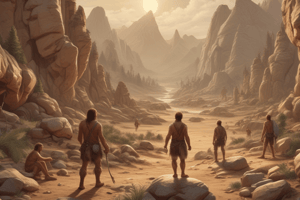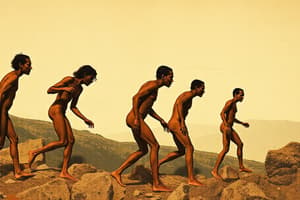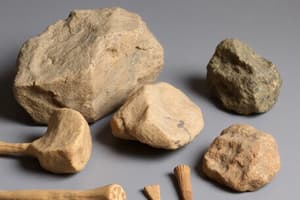Podcast
Questions and Answers
Which of the following best describes the primary factor driving technological development during the early human existence (BCE)?
Which of the following best describes the primary factor driving technological development during the early human existence (BCE)?
- An innate curiosity and a drive for artistic expression and cultural enrichment.
- A desire to understand the cosmos and the meaning of life.
- The need to establish complex social hierarchies and political systems.
- The primal need for survival and overcoming environmental challenges. (correct)
The generation gap is primarily caused by economic disparities between older and younger individuals.
The generation gap is primarily caused by economic disparities between older and younger individuals.
False (B)
Identify one way in which fire was used by early humans during the Stone Age to control their environment.
Identify one way in which fire was used by early humans during the Stone Age to control their environment.
scaring animals
The ___________ Age is characterized by the first use of stone tools.
The ___________ Age is characterized by the first use of stone tools.
Match the human species with their defining characteristic:
Match the human species with their defining characteristic:
Which of the following best describes the transition during the Chalcolithic (Copper) Age?
Which of the following best describes the transition during the Chalcolithic (Copper) Age?
The Bronze Age occurred at the same time period in every region of the world.
The Bronze Age occurred at the same time period in every region of the world.
How did the use of fire contribute to socialization among early humans?
How did the use of fire contribute to socialization among early humans?
What distinguishes Homo sapiens sapiens from earlier human species?
What distinguishes Homo sapiens sapiens from earlier human species?
The Mesolithic Age is primarily characterized by the __________ of technology.
The Mesolithic Age is primarily characterized by the __________ of technology.
Approximately how many species are estimated to go extinct each day based on current trends?
Approximately how many species are estimated to go extinct each day based on current trends?
According to the content, primal survival needs no longer contribute to habitat destruction and species extinction.
According to the content, primal survival needs no longer contribute to habitat destruction and species extinction.
What shift in primary goal, from survival, occurred as economies developed?
What shift in primary goal, from survival, occurred as economies developed?
According to Heidegger, technology can be seen as a ______ to achieve man's end.
According to Heidegger, technology can be seen as a ______ to achieve man's end.
Match each cause with its effect on the environment:
Match each cause with its effect on the environment:
Which of the following best describes the primary advantage of metal weaponry in the Bronze and Iron Ages compared to the Neolithic Age?
Which of the following best describes the primary advantage of metal weaponry in the Bronze and Iron Ages compared to the Neolithic Age?
Which of the following is NOT mentioned as a result of advancements in technology?
Which of the following is NOT mentioned as a result of advancements in technology?
The content suggests that increased reliance on technology poses no potential dangers to humanity.
The content suggests that increased reliance on technology poses no potential dangers to humanity.
Tools in the Metal Age were exclusively used for food preparation and personal grooming.
Tools in the Metal Age were exclusively used for food preparation and personal grooming.
What term is used to describe the current period of widespread extinction?
What term is used to describe the current period of widespread extinction?
What materials were primarily used for clothing during the Metal Age to combat harsh environmental conditions?
What materials were primarily used for clothing during the Metal Age to combat harsh environmental conditions?
What does the content suggest might happen if humanity continues on its current path?
What does the content suggest might happen if humanity continues on its current path?
The chariot in the Bronze and Iron Ages served as a supreme ______ weapon.
The chariot in the Bronze and Iron Ages served as a supreme ______ weapon.
According to the content, a self-sufficient community has to accommodate their ______ resources, leading them to be reliant to other communities’ products.
According to the content, a self-sufficient community has to accommodate their ______ resources, leading them to be reliant to other communities’ products.
Which of the following describes the role of chariots during the Eastern Zhou dynasty based on archaeological findings in China?
Which of the following describes the role of chariots during the Eastern Zhou dynasty based on archaeological findings in China?
Match the technologies with their respective eras:
Match the technologies with their respective eras:
What is the term used to describe the current, ongoing extinction event characterized by a high rate of species loss?
What is the term used to describe the current, ongoing extinction event characterized by a high rate of species loss?
The Holocene Extinction refers exclusively to the loss of plant species.
The Holocene Extinction refers exclusively to the loss of plant species.
Approximately how many species are estimated to exist on Earth, including those yet undiscovered?
Approximately how many species are estimated to exist on Earth, including those yet undiscovered?
The Holocene Extinction is also referred to as the ______ extinction, due to the significant impact of human activities.
The Holocene Extinction is also referred to as the ______ extinction, due to the significant impact of human activities.
Flashcards
Human Condition
Human Condition
The changes in human existence, often influenced by advancements like technology.
BCE
BCE
Time period before the traditionally numbered years, or before year 1.
CE
CE
Time period that starts at year 1
Generation Gap
Generation Gap
Signup and view all the flashcards
Human Condition (BCE)
Human Condition (BCE)
Signup and view all the flashcards
Homo Erectus
Homo Erectus
Signup and view all the flashcards
Homo Sapiens
Homo Sapiens
Signup and view all the flashcards
Stone Age
Stone Age
Signup and view all the flashcards
Palaeolithic
Palaeolithic
Signup and view all the flashcards
Fire in Stone Age
Fire in Stone Age
Signup and view all the flashcards
Metal Age Weaponry
Metal Age Weaponry
Signup and view all the flashcards
Metal Age Tools
Metal Age Tools
Signup and view all the flashcards
Metal Age Clothing
Metal Age Clothing
Signup and view all the flashcards
Chariot
Chariot
Signup and view all the flashcards
Construction Evolution
Construction Evolution
Signup and view all the flashcards
Water Transportation Evolution
Water Transportation Evolution
Signup and view all the flashcards
Cooking Evolution
Cooking Evolution
Signup and view all the flashcards
Agriculture Evolution
Agriculture Evolution
Signup and view all the flashcards
Holocene Extinction
Holocene Extinction
Signup and view all the flashcards
Extinction
Extinction
Signup and view all the flashcards
Primal Survival Needs
Primal Survival Needs
Signup and view all the flashcards
Growing Population Impact
Growing Population Impact
Signup and view all the flashcards
Community Formation Impact
Community Formation Impact
Signup and view all the flashcards
Overexploitation
Overexploitation
Signup and view all the flashcards
Global Warming & Pollution
Global Warming & Pollution
Signup and view all the flashcards
The Rise of Economy
The Rise of Economy
Signup and view all the flashcards
Technology's Impact: Mortality & Lifespan
Technology's Impact: Mortality & Lifespan
Signup and view all the flashcards
Technology Impacts
Technology Impacts
Signup and view all the flashcards
Essence of Technology
Essence of Technology
Signup and view all the flashcards
Study Notes
Lesson Objectives
- The lesson aims to explain the concept of the human condition before the advent of science and technology.
- It seeks to identify the changes that occurred in the human condition with the rise of science and technology.
- The lesson also aims to explore how technology has aided in revealing truths about human beings.
Two Timelines in History
- BCE(Before Common Era)
- CE (Common Era)
- 2000 BC = 2000 BCE = 3950 BP
- 2000 CE = AD = -50 BP
Generation Gap
- A generation gap is mainly attributed to changes brought about by technology
- Older generations may find newer technologies too complicated to operate.
Human Condition Before Common Era (BCE)
- Early ancestors' need to survive paved the way for various developments.
- Homo erectus, known as "upright man," lived between about 1.89 million and 143,000 years ago, and used fire to cook.
- Homo sapiens, known as "wise man," lived from the Paleolithic Age(Stone Age) about 200,000 years ago, and used stone as simple machines.
The Ages Before Common Era (BCE)
- Stone Age
- Palaeolithic (old stone age) saw the first use of stone tools, dating back approximately 2.8 million BP – 12,800 BCE
- Mesolithic (middle stone age) involved the development of technology dating back approximately c. 12,500 – 9,500 BCE
- Neolithic (new stone age) marked the development of technology and society, and was when Homo sapiens emerged around c. 9,400 – 7,000 BCE
- Chalcolithic (copper age) was a transitional period with copper metallurgy and stone tools being used together approximately c. 3,700 – 3,000 BCE
- Bronze Age which was approximately c. 2,000 - various over the world
- Iron Age which was varied across every region
Technology in the Stone Age
- Humans shaped rocks into hand axes using stone hammers, sharpening the edges with wooden, stone, or antler tools.
- Fire was used to control the environment, used for socialization, and cooking
- Fire was used for hunting to scare animals into kill sites.
Technology in the Metal Age: Bronze and Iron Age
- Weaponry in the Metal Age allowed cities to wage more successful wars and have more efficient means for defense as opposed to the Neolithic Age.
- Tools were used to prepare, contain, cut, and cook food. They were also used as personal grooming tools.
- Clothing made use of fur and animal skin for warmth against harsh winds and environmental conditions.
- Chariots were supreme military weapons used in battles with two people in it: a driver and a fighter using bow-arrows or javelin
Human Condition in the Common Era (CE)
- The Holocene Extinction is also called Anthropocene extinction or the "Sixth extinction," occurring from 100,000-200,000 years up to the present.
- It refers to the ongoing extinction of a number of species of both flora and fauna.
- The extinction of species on earth
- Approximately 1.5 species have already been discovered on Earth
- The actual amount of a species are estimated between 10 and 100,000,000
- Approximately 150-270 species become extinct
Causes of the Holocene Extinction
- Primal need to survive
- Growing population means more demand and less supply
- Community formation leads to habitat destruction and urbanization
- Illegal wildlife trade or overexploitation
- Global warming and pollution
Rise of Economy
- Gathering as much as possible became a new objective
- Communities become reliant on other communities products
- The primary goal of humanity changed from surviving to living a good life.
Advent of Technology
- Technology has advanced in medicine, health, and education.
- Mortality rates have reduced among women and children during birth due to technology.
- Advanced medical care for premature infants has increased.
- Science has prolonged lives and enhanced the living status.
- Remedies and medicine are distributed easier
- Access to education is easier
- Country income is brought by high productivity
Essence of Technology
- Martin Heidegger, a philosopher, argued that the essence or purpose of technology and being were different.
- According to Heidegger, technology is perceived either as a means to achieve man's end and it constitutes human activity, or as something that reveals a certain character regarding man's being
- A concern exists that our pursuit of technology may not lead us to the right direction or a good life
- A reliance on technology could lead to innumerable dangers and humans may reduce their surroundings to their economic value.
Studying That Suits You
Use AI to generate personalized quizzes and flashcards to suit your learning preferences.




